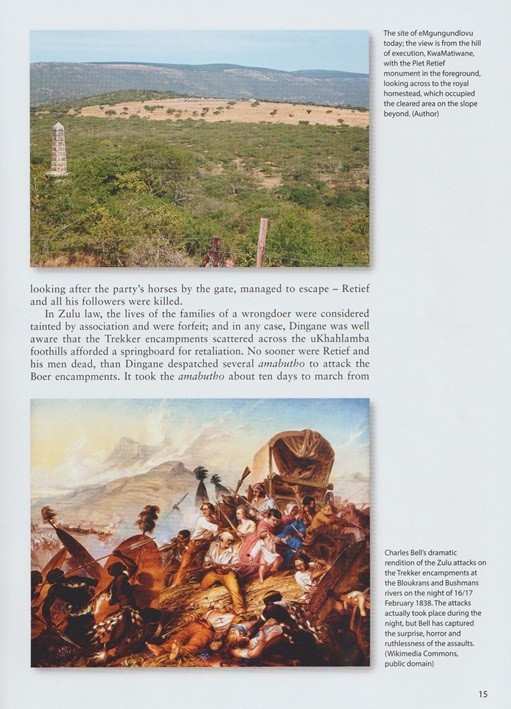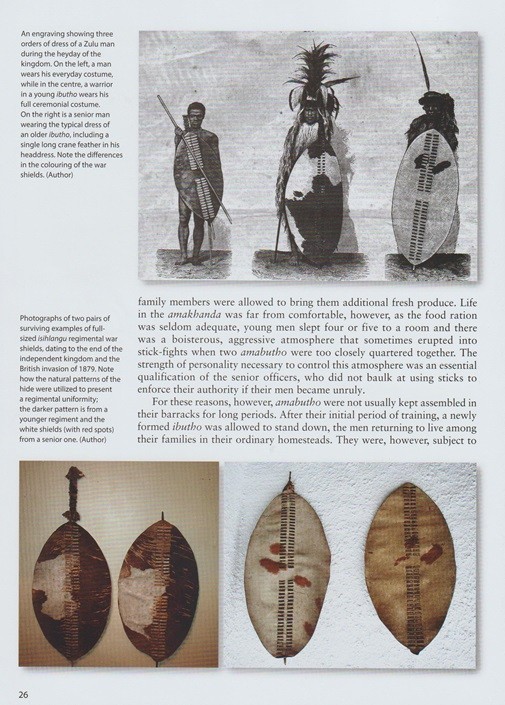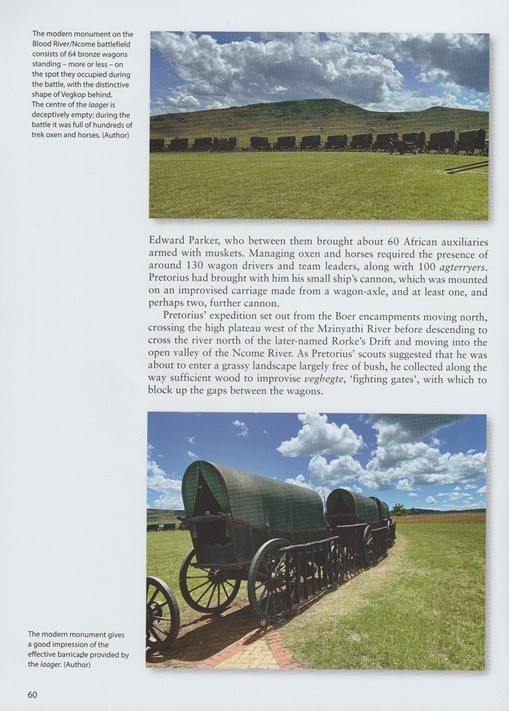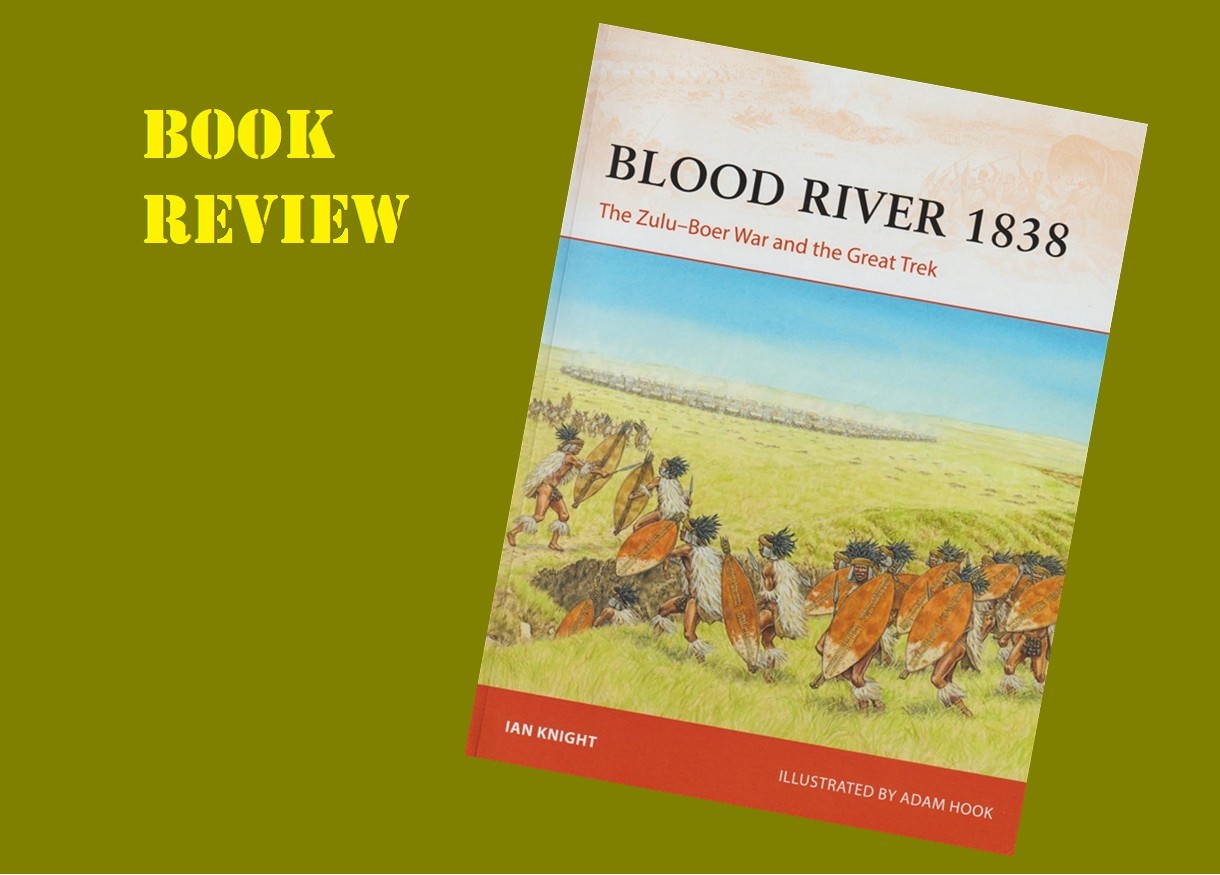
HISTORY:
** By the 1830s, the Zulu kingdom was consolidating its power as the strongest African polity in the south-east, but was under growing pressure from British traders and hunters on the coast, and descendants of the early Dutch settlers at the Cape – the Boers. In 1837, the vanguard of the Boers' Great Trek migration reached the borders of Zulu territory, causing alarm. When the Boer leader Piet Retief and his followers were killed, war broke out. Although the initial Boer counterattacks were defeated by the Zulus, in December 1838 a new Trekker offensive resulted in a nation-defining clash between Boer and Zulu at the battle of Blood River.
In this carefully balanced new study, containing stunning artwork and detailed maps, Ian Knight explores what has long been a controversial and partisan topic in South African history, placing the Zulus more squarely in this part of their story. Among the topics covered are the 1836 Boer-Ndebele conflict, the imbalance in technique and weaponry, the reasons why the British settlers allied themselves with the Boer Trekkers, and why the war was a key turning point in the use of traditional Zulu military techniques. This book also reveals that a Boer victory at Blood River was by no means a foregone conclusion. **
** Quoted from the back cover of the book.
THE BOOK:
Osprey Publications has released Blood River 1838, The Zulu–Boer War and the Great Trek as Number 402 in their Campaign series. It is a soft cover book with 96 pages and is the standard Osprey Publishing size of 7 1/4 x 9 3/4 inches. Included with the text are black and white photographs and color photographs, color illustrations, 3-dimensional ‘birds-eye-view’ maps, maps, detailed captions and more. It has a 2024 copyright, a publication date of November 21, 2024, and the ISBN is 978-1-4728- 6075-0.
THE CONTENTS:
- Origins of the Campaign
- The outbreak of war
- Chronology
- Opposing Commanders
- Zulu
- Voortrekker
- Opposing Forces
- Zulu
- Voortrekker
- Port Natal settlers
- Orders of Battle
- Opposing Plans
- The Campaign
- The battle of eThaleni
- The battle of Thukela
- The battle of Veglaer
- The Blood River/Ncome expedition
- The battle of oPathe
- The battle of amaQongqo and the end of the war
- Aftermath
- The effects of the war
- The Battlefields Today
- Further Reading and Bibliography
- Index
** The Osprey Publishing website states that the contents list shown with the book listing is “subject to confirmation”. The contents listing I have provided has been quoted from the book and is accurate.
THE TEXT:
Author Ian Knight has written an excellent history about the 1838 Zulu–Boer War and the Great Trek and has done an excellent job of detailing and discussing the conflict in a well written and easy to follow and understand manner. The text goes into very specific detail in all areas of the book as outlined on the contents page, please refer to the contents listing that I have provided for the areas that are covered through the book. Along with his own words Ian Knight has also provided a quote from Boer soldier Dirkie Uys regarding his wounded father and also from a missionary who gave his impression of the passing settlers. The text in the book is nicely written and well detailed. As I read through the text, I didn’t notice any spelling or grammatical errors. Grammar and spelling might not be an important factor to everyone however it is something that I take notice of and pass on my findings. I feel that if the text is well written then it shows that the author has taken the time to be professional with their writing. As a reader that knew basically nothing about the 1838 Zulu–Boer War and the Great Trek, I found myself to be well informed on the subject upon finishing the book. Anyone wanting to add an excellent reference and history book on the Zulu-Boer War in 1838 and the Great Trek to their personal library will be pleased with this very informative and interesting book.
THE PHOTOGRAPHS:
A total of 42 black and white photographs and 39 color photographs are included in this volume. Several of the photographs are of period illustrations and paintings and provide the reader with details of various weapons, gear and period uniforms and clothing. They also provide a good reference for coloring which can be used as a painting guide for modelers if so chosen. The images are obviously not always in scale and 100% accurate but I personally feel that they still do their job of providing information as photography was in its infancy in that time period. So obviously, artists were free to use artistic interpretation when they created their paintings and illustrations. The majority of the photographs are clear and easily viewable; however, a few have an out of focus look to them and some appear to be too dark, and others appear too light. This is typical for the discussed period of history and the quality of the photographs is no fault of the author and do not take anything away from the book. Author Ian Knight stuck to the title of the book and chose subject specific photographs and did not include photographs that strayed from the main subject. The majority, if not all, of the photographs will prove to be excellent reference material for the scale figure modeler due to the details they contain. The military historian, and the military uniform and smalls arms enthusiast will benefit from the excellent photographs as will anyone that is interested in Zulu warfare, as well as the Boers, in the 1800s.
THE ILLUSTRATIONS:
There are three color illustrations by illustrator Adam Hook provided in this volume. Each of the color illustrations is a two-page action illustration and on the following page is a smaller black and white copy of the same illustration that describes the scene and points out and details key areas of interest. The illustrations are very well done, nicely detailed and are of:
Plate A
The climax of the battle of the Thukela, 17 April 1838
- A two-page action color illustration depicting the first clash between a military influenced army and the Zulus as the settler’s scrimmage line begins to collapse as the Zulus press the attack near the burning ‘Ndondakusuka homestead.
Plate B
The Zulu Attack at Blood River/Ncome, 16 December 1838
- A two-page action color illustration depicting the start of the main phase of the battle, as the right horn of the Zulu army crosses to the south of the Boers defensive encampment (laager) formed by a circle of wagons. (A portion of this illustration is shown on the front cover of the book.)
Plate C
Inside the Laager at Blood River/Ncome, 16 December 1838
- A two-page action color illustration depicting the fighting that took place between the Zulus and the Boers at the Boer laager.
THE MAPS:
There are 5 color maps included in this volume that are accompanied by a compass rose and detailed keys that point out specific locations as well as movements and actions by both sides of each conflict.
The maps are of:
- The Boer-Zulu War, February-April 1838
- The battle of eThaleni, 10 April 1838
- The war, May 1838-February 1840
- The battle of oPathe, 27 December 1838
- The battle of amaQongqo, 29 January 1840
3-DIMENSIONAL ‘BIRDS-EYE-VIEW’ MAPS:
There are two 3-dimensional ‘birds-eye-view’ maps included in this volume and there are of:
- The Battle of the Thukela, 17 April 1838, 0600-1000HRS
- The Battle of Blood River/Ncome, 16 December 1838, 0400-1300HRS
The 3-dimensional ‘birds-eye-view’ maps are accompanied by a compass rose, keys listing both Zulu and settler/Boer units and showing their locations on the map as well as an events listing showing movements by both sides of the conflict.
THE CAPTIONS:
The captions are well written and explain the accompanying photographs and illustrations in great detail eliminating any doubt as to what is shown. The captions go into very specific detail as to the names of specific individuals shown and their military rank or title, the types of uniforms and accoutrements, weapons and equipment carried and used, specific battles, dates and locations and other such pertinent information. I found Ian Knight’s captions to be very informative and they will be helpful to the reader due to their detailed content as opposed to other captions that I have seen that are very brief and lacking in detail.
CONCLUSION:
As with the other Osprey Publishing titles I was impressed with this book. This is a very nice reference book that contains a well written informative text, many subject specific photographs and illustrations, well detailed captions and more, all detailing the Zulu-Boer War in 1838 and the Great Trek. As with the other Osprey Publishing titles, I have no hesitation recommending this book to others as it will be a welcome addition to one’s personal reference library.
** I did notice that on pages 76, 80 and 81 there are blue ink stains. However, the volume that I received might be the only one that has the stains, and the stains do not interfere with being able to read the text or view the photographs, but I thought it should be mentioned.
Osprey Publishing also offers Blood River 1838, The Zulu–Boer War and the Great Trek as:
Ebook (Epub & Mobi) ISBN: 978-1-4728-6074-3
and
Ebook (PDF) ISBN: 978-1-4728-6073-6
Osprey Publishing’s, Blood River 1838, The Zulu–Boer War and the Great Trek is also available as a Kindle version through Amazon.
PRICE:
UK £16.99 / US $25.00 / CAN $33.00
This book was provided to me by Osprey Publishing. Please be sure to mention that you saw the book reviewed here on the KitMaker Network when you make your purchase. Thank you.


































